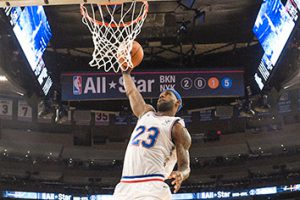Indy officials confident city measures up to NCAA’s new standards
Local officials say Indianapolis should continue to host NCAA events despite rules adopted by the association on Wednesday to assure LGBT rights and protections.
Local officials say Indianapolis should continue to host NCAA events despite rules adopted by the association on Wednesday to assure LGBT rights and protections.

In a sign of the city’s serious intent to host the game, Pacers President Rick Fuson will be accompanied by presidents and vice presidents of Visit Indy and the Indiana Sports Corp. as he travels to Toronto this week.

Indianapolis hasn’t hosted the NBA All-Star Game since 1985—when it was in the Hoosier Dome—something the league’s commissioner, Adam Silver, wants to change. But local officials haven’t pulled the trigger on a bid.
Indianapolis leaders have decided that they won’t try to land the College Football Championship Game, despite the hundreds of millions of dollars in potential economic impact for the city.

A deal struck 10 years ago to bring the men’s Final Four to Indianapolis every five years has become a much-beefier cash cow for the city than any of the pact’s architects could have imagined.
USA Track & Field is sprearheading an effort to bring a unique outdoor track and field competition to the streets surrounding Monument Circle.

Ann Lathrop explains why she’s stepping away from the city’s Capital Improvement Board after helping pilot its recovery and cutting a deal to heavily subsidize the Indiana Pacers’ operation of Bankers Life Fieldhouse.
After Allison Melangton stepped down as president of the Indiana Sports Corp. to become a Hulman & Co. executive, Ryan Vaughn resigned as Mayor Greg Ballard's chief of staff and succeeded her.

Ryan Vaughn says one of the not-for-profit’s first considerations under his tenure, when going after or creating any sporting event, will be opportunities for area businesses beyond the usual benefits to hotels and restaurants.
The change of guard at Indiana Sports Corp. will take place in late October, giving Ryan Vaughn time to finish out negotiations for the city’s 2015 budget, currently under review by the City-County Council.
Allison Melangton plans to step down as Indiana Sports Corp. president and will become senior vice president of events with Hulman & Co., parent of the Indianapolis Motor Speedway. Ryan Vaughn, chief of staff to Indianapolis Mayor Greg Ballard, will succeed Melangton.
Marian University, St. Vincent Health and four amateur sports groups have entered into formal discussions that could result in major developments at the northwest-side campus, the university announced Tuesday.
The Capital Improvement Board of Managers of Marion County voted Monday to give the Indiana Sports Corp. $500,000 a year for the next 10 years to create a reserve fund for maintenance on the IU Natatorium at IUPUI.
Mayor Greg Ballard on Monday morning unveiled details of the plan, in which IUPUI and Lilly Endowment each contribute $10 million for the IU Natatorium renovation. The city’s $10 million part of the plan involves nearby streets.
A stinging defeat for Indy’s quest to land the 2018 Super Bowl leaves a giant opening in the city’s convention schedule and brings new urgency to recruiting future sports events.
It’s unclear what’s next for Indianapolis, which hosted its first Super Bowl in 2012. Organizers said it’s simply too early to consider going for another Super Bowl. It seems bidding next year for the 2019 game is off the table.
Indianapolis is betting that an ambitious project to study safety issues at all levels of football, plus expanding and snazzing up the Super Bowl Village, will help win the 2018 Super Bowl. And Jeff Saturday will help deliver the message.
Demand for tickets and local hotel rooms spiked once it became clear that Kentucky and Louisville would meet in the Sweet Sixteen at Lucas Oil Stadium this weekend.
The battle on Saturday between Ohio State and Michigan State, plus ESPN broadcasts and special events downtown, are expected to have a $15 million economic impact on Indy. That’s a vast improvement over the 2012 championship.
Mayor Greg Ballard is proposing to pay about half of the $20 million needed to upgrade the Natatorium at IUPUI. The city's Capital Improvement Board is also considering setting aside tax revenue for operation expenses.